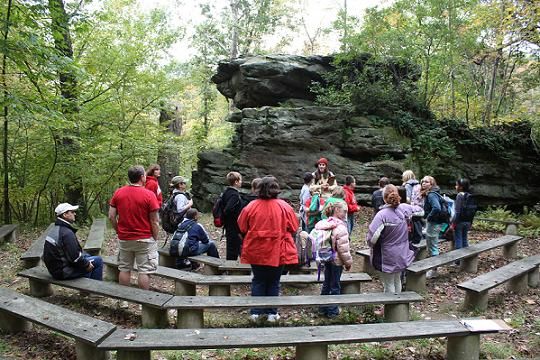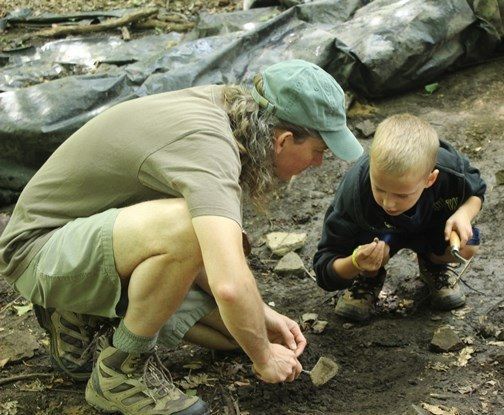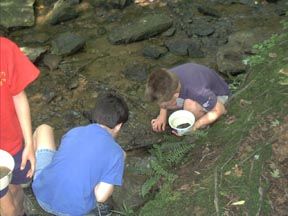Field Trip Curriculum
Program Options Guide

The Lutherlyn Environmental Education Program (LEEP) customizes each field trip.
The Program Options contain activities that are currently available and a brief description of each. All activities are hands-on. The duration of each activity is listed to facilitate scheduling. Grade levels are also listed, but activities are adapted for each particular grade level. For example, a 9th grade class learning about the forest will study it at a different level than a 4th grade class.
If you are interested in concepts that are not listed under these options, please contact the LEEP staff and we will work with you to design appropriate activities.
Please note: Each activity is followed by a listing of which Pennsylvania Department of Education Academic Standards the activity can be applied to. At this point, the activities have been cross-referenced to the academic standards for Environment & Ecology (4.x.x), History (8.x.x), Science & Technology (3.x.x), Mathematics (2.x.x) and Reading, Writing, Speaking & Listening (1.x.x). These standards are available from the Pennsylvania Department of Education on the Web at www.pdesas.org/standard
Click on any category to see the detailed descriptions of each activity. ...or
-
Animal Tracking
Adaptation
Bird Observation Hike
Creating Habitats
Habitat and Wildlife
Insect Investigation
Pond Study
(see Water section)Predator/Prey Relationships
Stream Investigation
(see Water section) -
Creative Expression
Display and Discovery Room
Grab Bag
Journal Writing
Sensory Exploration
-
Ecosystem Investigation
Forest Comparison
Marsh Investigation
Healthy Forest
Pond Study
(see Water section)Stream Investigation
(see Water section) -
Archaeology
Early Settlers and the Venango Trail
Frontier Life
The Historic Semiconon Valley
Life Skills of the Woodland Tribes
Edible and Medicinal Plants
(See description in Plants section)Games
Nonverbal Communication
Shelter
Trapping and Tracking
-
Compasses
Group Building (Challenge Course)
Orienteering
Survival Challenge
Survival Skills
-
Edible and Medicinal Plants
Tree Identification
Tree Parts and Functions
Maple Sugaring
(See Special Programs section) -
SPECIAL PROGRAMS
The programs listed below are complete field trip experiences. The activities in each program are the same for each field trip. Although a portion of these programs may be integrated with the Programs Options listed previously, these are primarily stand-alone programs. These programs are seasonal in nature and can only be scheduled at certain times of the year. Please note the seasons specified in the information below.
Archaeology
Duration: 5 hours – several days
Grade Level: 4th - AdultIn this ultimate hands-on field trip experience, students delve into the exciting world of archaeology and really "get their hands dirty". Students learn the basics of setting up an actual archaeological dig and how to carefully excavate a site. Western Pennsylvania history comes alive as students unearth artifacts, clean what they have found, and try to identify these clues to the past. The current dig site has been the site of human activity for hundreds of years. There is evidence of Native American, as well as pioneer, activity. In order to preserve the integrity of this archaeological site, group size may be limited. For an extended Archaeology experience, this may be done as a multi-day/overnight field trip. The seasons for this program are April-May and August – November.
Maple Sugaring
Duration: 3 ½ - 5 hours
Grade Level: K -AdultThis field trip experience allows students to learn about biology and an aspect of pioneer and Native American cultures. Maple Sugaring is a high interest, hands-on program divided into four separate activities. Students begin by learning about tree parts and their functions, learning where the sap comes from, and how the sugar got into the sap in the first place. In the second activity, students are taught the basics of winter tree identification. Following this identification lesson, students locate maple trees and measure their circumference to determine if the trees are "tappable." Groups of students then drill holes in the trees, tap in the spiles, and hang the buckets. The final activity involves collecting sap from many maple trees and taking it to the Sugar Shack, where a sugar maker is making maple syrup. The boiling process is demonstrated at the Sugar Shack and students get to taste the finished product. These four activities are interwoven with Native American stories and explorations of pioneer and Native American sugaring techniques. Older students delve deeper into tree physiology and the calculations of sap flow. For an additional fee, students may have a pancake and maple syrup lunch. The Maple Sugaring experience may also be done as an overnight field trip, giving the students more time to participate in the sugaring process. Maple Sugaring season runs from the beginning of February through the middle of March.
-
Creating Habitats
(see Animals section)How Many Trees?
Integrated Pest Management
Re-Cycling/Completing the Loop
Terra Dei Homestead Tour
Trash Stash
World Population Simulation
-
Abandoned Mine Seep
Food Chain/Food Web
Marsh Investigation(see Ecosystem section)
Microscopic Life
Pond Study
Stream Flow Calculation
Stream Investigation
Water Cycle/Watersheds
Water Quality Testing









